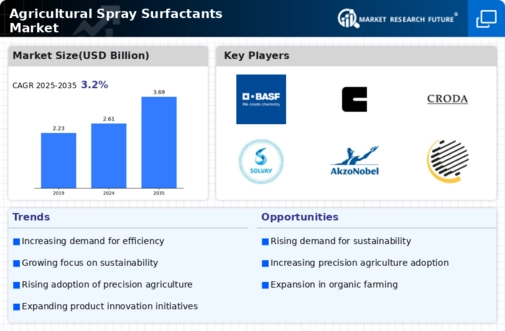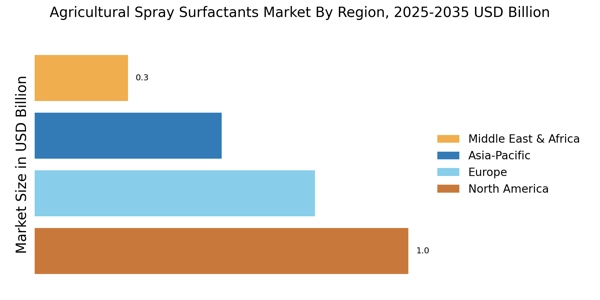Rising Demand for Crop Protection
The Agricultural Spray Surfactants Market is experiencing a notable increase in demand for effective crop protection solutions. As agricultural practices evolve, farmers are seeking products that enhance the efficacy of pesticides and herbicides. This trend is driven by the need to maximize yield while minimizing environmental impact. According to recent data, the market for agricultural chemicals, including surfactants, is projected to grow significantly, with an estimated compound annual growth rate of around 5% over the next few years. This growth is indicative of a broader shift towards integrated pest management strategies that rely on surfactants to improve the performance of active ingredients in crop protection products.
Advancements in Formulation Technology
Innovations in formulation technology are playing a crucial role in the Agricultural Spray Surfactants Market. The development of new surfactant formulations that enhance the wetting, spreading, and penetration of agrochemicals is becoming increasingly important. These advancements not only improve the effectiveness of pesticides but also reduce the quantity needed for application, thereby lowering costs for farmers. Recent studies suggest that the incorporation of advanced surfactants can lead to a 20% increase in pesticide efficiency. As a result, manufacturers are investing in research and development to create more effective and environmentally friendly surfactants, which is likely to drive market growth in the coming years.
Growing Awareness of Sustainable Practices
There is a growing awareness of sustainable agricultural practices within the Agricultural Spray Surfactants Market. Farmers are increasingly recognizing the importance of using eco-friendly surfactants that align with sustainable farming principles. This shift is driven by consumer demand for sustainably produced food and the need to comply with environmental regulations. Recent surveys indicate that over 60% of farmers are willing to invest in sustainable products, including surfactants, that enhance crop yield while reducing environmental harm. This trend is likely to propel the market for biodegradable and non-toxic surfactants, as manufacturers respond to the demand for greener alternatives.
Increased Adoption of Precision Agriculture
The Agricultural Spray Surfactants Market is benefiting from the rising adoption of precision agriculture techniques. Farmers are increasingly utilizing technology to optimize their agricultural practices, which includes the precise application of surfactants. This approach not only enhances the effectiveness of agrochemicals but also minimizes waste and environmental impact. Data indicates that the precision agriculture market is expected to reach a valuation of over 10 billion dollars by 2026, which will likely drive demand for specialized surfactants that cater to these advanced application methods. As precision agriculture continues to gain traction, the need for high-performance surfactants will become more pronounced.
Regulatory Support for Agrochemical Innovations
The Agricultural Spray Surfactants Market is also influenced by regulatory support for innovations in agrochemicals. Governments are increasingly recognizing the need for effective pest control solutions that are safe for both the environment and human health. This has led to the establishment of regulatory frameworks that encourage the development and use of advanced surfactants. For instance, recent policy changes have streamlined the approval process for new surfactant formulations, making it easier for manufacturers to bring innovative products to market. This regulatory support is expected to foster growth in the agricultural surfactants sector, as companies are incentivized to invest in research and development.


















Leave a Comment